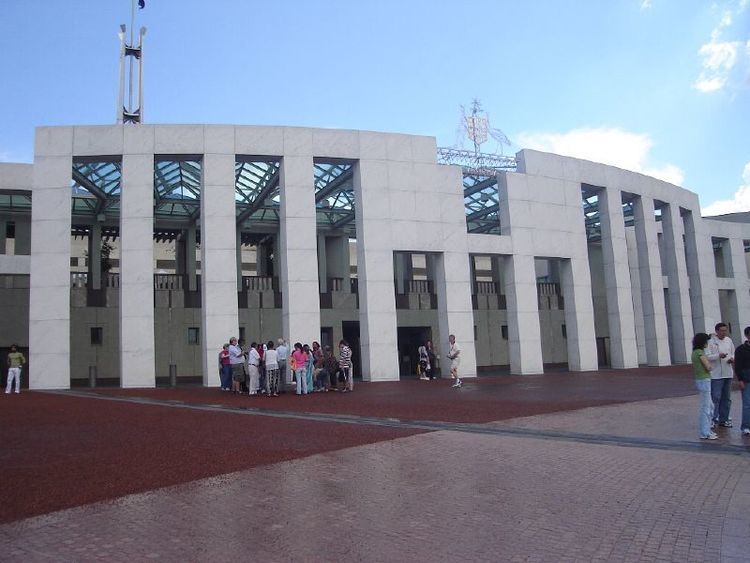 | ||
The 1996 Parliament House riot (also called the Canberra riot) involved a physical attack on Parliament House, Canberra, Australia, on 19 August 1996, when protesters broke away from the "Cavalcade to Canberra" rally organised by the Australian Council of Trade Unions (ACTU) and sought to force their way into the national Parliament of Australia, causing property damage and attacking police.
Contents
Overview
The Australian Council of Trade Unions called the "cavalcade to Canberra" rally to protest against the industrial relations reform agenda of the Liberal-National Coalition Howard Government. The protest began with senior Australian Trade Union officials including ACTU President Jennie George and Assistant Secretary Greg Combet, as well as senior members of the Australian Labor Party rallying demonstrators from a podium.
According to then President of the Senate, Margaret Reid, the initially peaceful protest deteriorated into violent action when a new group of demonstrators arrived in the early afternoon and, joined by people from the main protest, attacked the entrance to Parliament. Around 90 personnel were injured —including lacerations, sprains, and head and eye injuries. Damage to the forecourt and foyer of Parliament was initially estimated at $75,000 and the Parliamentary shop was looted. Nine rioters were arrested and charged with a variety of offences.
Background
Before the 1996 Australian Federal election, ACTU Secretary, Bill Kelty, had threatened 'industrial war' if a Coalition Government tried to challenge union power. Following their 1996 election victory, the Howard Government proposed to balance the Australian federal budget by means of extensive budget cuts, and introduced a draft Workplace Relations Amendment Bill which proposed to curtail 'compulsory unionism' and to introduce a more decentralised bargaining structure to the Australian work place. Both endeavours were opposed by Trade Unionists who organised a campaign of protest to culminate on the eve of the federal budget, 19 August 1996 with a protest rally on the lawns of the Federal Parliament, called the "Cavalcade to Canberra".
The protest and riot
On 4 July 1996, the A.C.T. Trades and Labour Council advised the Speaker and President of the Parliament that a rally would be held at Parliament House on Monday, 19 August and requested permission to conduct a march around the Parliament building. The march was approved for between 1.35 p.m. and 2.25 p.m, provided adequated marshalling was organised and that the demonstration did not obstruct access to Parliament. Subsequent discussions were also conducted with the Construction, Forestry, Mining and Energy Union and the indigenous representatives and all agreed to these parameters for the demonstration. On the day of 19 August, The protest rally remained peaceful until about 12.20 p.m. at which point a separate group of demonstrators entered the parliamentary precinct. The following day, the President of the Australian Senate outlined to Parliament the events that followed thus:
During the course of the riot, unionist Davie Thomason, of the CFMEU, took the podium at the official rally with a bloodied face and spoke while shaking a police riot shield, saying to cheers from other protesters:
Addressing the Senate the following day, Senator Robert Hill, leader of the Government in the Senate, described the event as "very sad day in the history of the Australian political process", and his opposition counterpart Senator John Faulkner condemned the "appalling violence" on behalf of the opposition. Senator Cheryl Kernot for the Australian Democrats said she "condemned" the violence and "I deplore the actions of those who, in my opinion, selfishly and deliberately chose to distract from discussion of the issues". Senator Dee Margetts, speaking for the Greens Western Australia said that "the Greens WA do not associate ourselves with the violent action" but that "there are obviously some in the Greens movement who have differing opinions about that". In the House of Representatives, Opposition Leader Kim Beazley called the rioters "lunatics" and "louts" who had distracted from a "peaceful and lawful" protest, while Prime Minister John Howard described the violence as "thuggery" and said that the ACTU should accept some responsibility for the riot:
